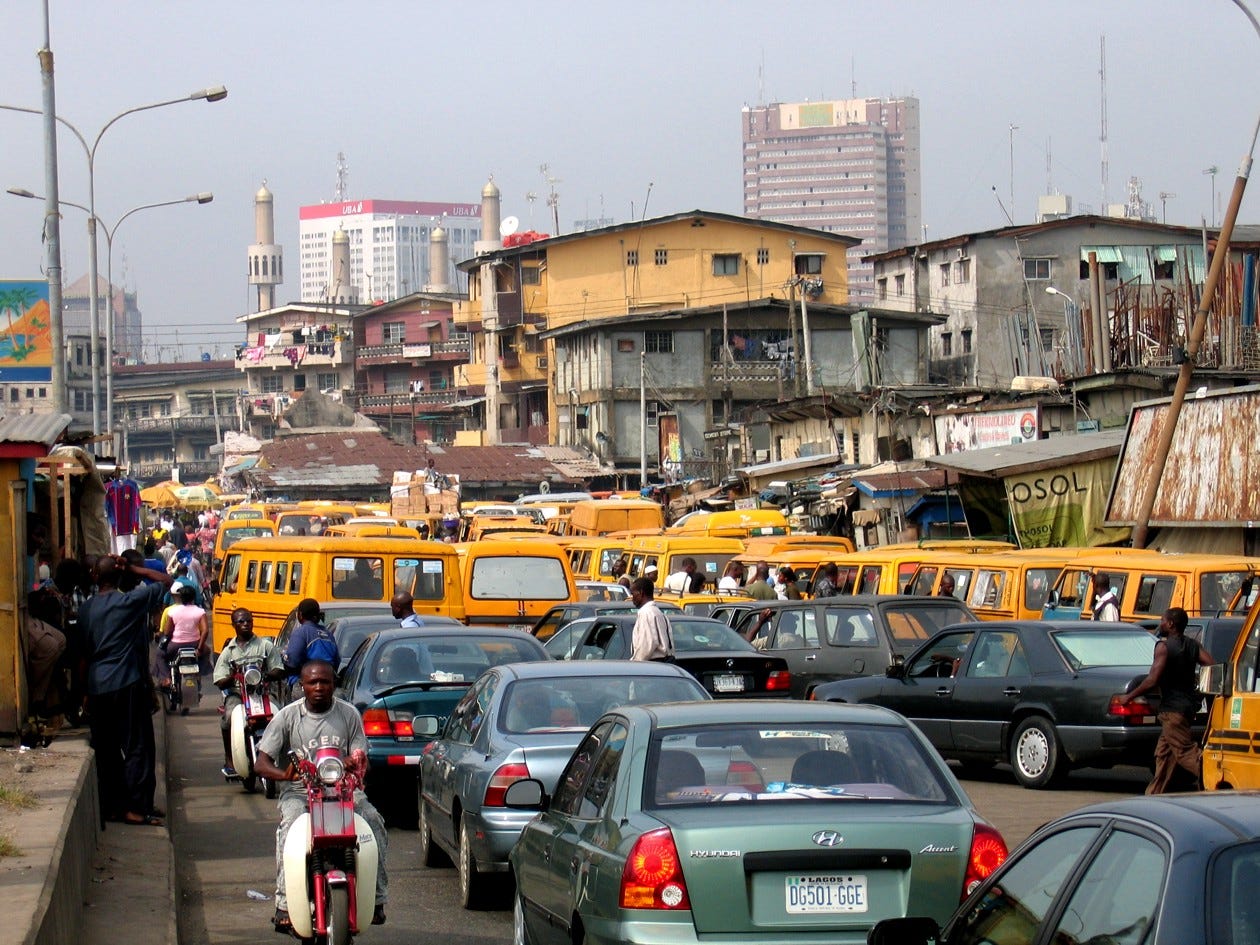Lagos: A crowded lagoon city and its transport troubles.
A look at how the most populous city in Africa struggles with its transportation system.

Image by Alf Gillman
For everyday commuters in Lagos, the frustration of traffic is obvious. Everyone detests the congestion in the city, but it seems to never get better, despite the state government’s best efforts.
Traffic congestion is an inevitable reality in largely populated cities. Lagos, which is one of those cities, is built on about 10 Lagoons and seems to be worse off than most. Nigeria’s former capital has the highest one-way time needed to transport (65 minutes) in the world.
Traffic congestion happens when too many people want to move at the same time in very constrained spaces. As people head to work, go to school, and run errands during the same hours of the day, they end up bumping into each other and inevitably overload transport systems.
Successive governments in Lagos have made it a ritual to ban motorcycles commonly called okadas from particular roads in the state. In its current form, the ban is on commercial okadas and keke marwa (tricycles), prohibiting them from plying highways, bridges and particular roads in some LGAs (local government areas). Citing the climb of fatal accident cases in the city as its primary reason, the state government is enforcing this directive. A move that almost ran motorcycle ride-hailing startups Gokada, Oride and Max out of town.
As people started to adjust to the shock of the current ban, the state government announced new regulation fees on car ride-hailing startups like Uber and Bolt.
It is around this time a story broke out, announcing a partnership between the state government and a mysterious ride-hailing company called Ekocab. The goal of the partnership is to give more leverage to local taxi drivers that had seen a reduction in revenue since ride-hailing companies moved into town.
Apparently, the Ekocab CEO consults for the Lagos government on mobility policy matters. He comes on Twitter like a bird, singing a thread on how the opportunity fell into his lap, how lobbying isn’t legal, and how Ekocab was going to share its gathered data with the government. This brought up questions on ethics and data privacy, resulting in some cancel culture participation from not so happy Lagosians. With some of them even going ahead to download the app to give it a poor rating.
Too Many People, Too Few Bad Roads.
Road transportation is a principal element for developing an integrated transport system. It is the vital link that connects all the other modes of transportation. A case can certainly be made that it is a lifeblood of developed economies. Unfortunately for Lagos, its existing 9,100 road network has become very inadequate for the city’s population.
Moving around in this city of over 21 million people, especially with public transport can be hellish. More so during the raining season. Where a mix of bad drainage and poor maintenance make it seem like a hurricane just hit the city.
The city's road network is always brimming with private and commercial vehicles. A pool of vehicles that includes cars, buses, trucks, okadas, and kekes.
Some 1.6 million vehicles are on Lagos roads daily. Catering for over 8 million people commuting daily in the state.
Nigeria has a national average of 16 cars per km/road but our dear Lagos runs riot with 226 cars per km/road. A 173% difference. This difference is partly why Lagos has high volume traffic that causes delays in travel time for people and the movement of goods. It is partly why there is a significant increase in the rate of crime and accidents in the state. It is why the state loses billions of naira each year. It is also why Lagos ranks low in quality of life rankings.
Losses in Lagos
Lagos has experienced a 1400% increase in its population from 1.4 million people in 1970 to 21 million in 2020. Since 1970, over 19 million people have moved into Lagos without sufficient planning or infrastructure to cater to them.
People who live and commute within Lagos spend on average 30 hours in traffic each week. That is 75% of the time used at work weekly, by people who have 5-day workweeks and 8-hour workdays.
When people spend 75% of the time they ought to devote to meeting KPIs, with commuting to work, it can have negative effects on their productivity. This often triggers losses for both employers and employees.
In 2016 the Lagos government reported that the state loses 42 billion naira annually due to the city’s traffic jams. This negatively affects the national economy as well because of the importance of the state as a commercial hub to the country. For more context, Apapa seaport, which is Nigeria’s largest seaport, costs the country $19 billion annually due to the gridlock the port constantly experiences.
Two Steps Forward, One Okada Ban Back
As the Lagos state government tries to improve its road network, work on its bus network service, and explore its waterways. Its ban on a key component of the public transport system is bizarre. It places more strain on a system that is already buckling under immense weight.
Since the end of military rule in 1999, all four democratic Governors of Lagos state, from Tinubu to Sanwo-Olu have placed a full or partial ban on okadas in the state.

Especially as the state gradually seeks to come out from the Covid-19 induced lockdown. A ban on an important means of transportation like okadas and kekes, has made commuting for Lagosians even more difficult. As those who use public transport have to walk longer distances, experience longer wait times at bus stops (for even fewer buses) and pay higher transport prices.
While it is a bit hard to gauge the total impact of two-wheelers and three-wheelers in Lagos state, we can start with what we know is true of motorcycles and tricycles in Lagos.
Okadas and kekes help people go places faster than if they were commuting in cars or buses as they require less space to navigate in.
They provide a means of living for those who might have likely turned to crime, because of the low barrier to entry in terms of skill and due to many rampant higher purchase schemes.
The availability and flexible pricing of motorcycles makes them a great mode of commuter transportation.
Their ability to reach the nooks and crannies of the towns and villages.
Motorcycles have become so important in Africa because of their last-mile feature that has powered commerce on the continent. Victor Asemota, a popular investor and commentator on tech in Africa posits that motorcycles more than mobile phones have changed Africa the most.

At the heart of the okada ban in Lagos, a question of whether the benefits of having okadas and kekes in Lagos outweigh their enforced absence persists.
The means of road transportation in Lagos before motorcycles came to the fore, were basically molues (49 seater buses), danfos (mini & medium-sized buses) - a government-run bus transport service, bolekaja (wooden lorries used for carrying goods and passengers), and kabukabu (private cars used for commercial transport) taxis. The other mode of transport in Lagos was the railway. Even though motorcycles existed since the colonial times in Nigeria, it wasn't till the transport system in Lagos started to suffer as the population in the state grew, that it started to gain popularity as a means of commercial transport in the city.
A huge criticism of the use of okadas in Lagos state has been the links to the rising number of road accidents. Another criticism of motorcycles in the state is the inconvenience they cause on highways and bridges as the riders do not obey traffic rules. This, in turn, pushes to the fore, concerns over criminal activity and of course, pollution in the city.
Critics have suggested policies like outright or partial bans as a way of combating these issues.
We can attribute the high rate of accidents to the lack of training and traffic education as well as impatience among okada riders, as well as their flagrant disregard for traffic rules and regulations, among other factors.
On the other hand, some that okadas are vital to the city's transport system and argue that milder measures, such as regulation, will be a more realistic solution than bans. Suggesting measures like restricting the operations of okadas on roads that have minimal traffic, enforcing traffic regulation on riders of motorcycles, and training riders on the state’s traffic codes. A state-wide riding test should also be carried out. Only those who pass the test should be granted permission to ride motorcycles in Lagos.
Taming the Transport Monster
The different modes of transportation in Lagos are incredibly lacking in synergy. This has brought on mobility inefficiencies that when coupled with the city’s bursting population, forms the base of its hellish traffic problem.
Enter the Lagos Urban Transport Project (LUTP), a World Bank-supported programme that seeks inspiration from innovative transportation projects implemented in cities like Coritiba(Brazil) and Bogota(Colombia). The project focuses on efficiently integrating the different modes of transportation available to the state in a bid to cut mobility costs, average travel times and CO2 emissions.
The modes of transportation LUTP focuses on include the Bus Rapid Transit (BRT), Ferry services (water transport), Lagos Urban Rail Network(LURN) and cable car. Other aspects that LUTP focuses on are institutional development for the Lagos Metropolitan Area Transport Authority (LAMATA) and the improvement of transport infrastructure (i.e road networks). This is all based on a Public-Private Partnership (PPP) with private sector operators.
The LUTP project kicked off when BRTs were introduced in Lagos in 2008 to run on designated traffic lanes. The BRT buses are sourced, operated and maintained by private sector operators, while LAMATA regulates the sector and caters to infrastructure.
However, the BRT project is yet to meet the high demand for commuters because of its low number of BRT buses and poor maintenance of the buses. Despite creating jobs and reducing the cost of travel as well as travel time by about 20 per cent.
Water transport is certainly an avenue for reducing the congestion on roads in the state and relieving traffic on the road networks. The LUTP water transport program involves using ferry services on the state waterways to reduce travel time and pollution.
However, using water transport in Lagos is more expensive than using road transport. Still, the use of water transportation is starting to gain popularity with commuters in Lagos because it saves time. Making it worth the price for some.
Yet just like the BRT project, the fleet of ferries in Lagos is still not enough to meet the demand of everyday commuters in the state.
The Lagos Urban Rail Network(LURN), the rail element of LUTP has yet to become functional. The LURN project is estimated to serve 400,000 passengers daily. The Lagos Rail Mass Transit which will consist of 7 rail lines is billed to commence operation in 2022.
Cable car transport is the last piece of the LUTP program. It aims to target areas that are underserved by BRT, LURN and the ferry service. The implementation of Cable car transport is yet to kick off in Lagos.

Image from gettyimages
Other than LUTP, the Lagos government has kicked off other transportation initiatives in the state. Such as the construction of a 4th mainland bridge and a new airport in Lekki.
Going Forward
Moving around in Lagos is an experience that involves long wait times caused by never-ending queues, traffic-ridden roads, ill-maintained vehicles, disregard of traffic rules by drivers with complicit local and federal authorities.
The policies taken by the government such as the bans on motorcycles and its LUTP program gives off mixed signals.
Motorcycles and tricycles have become an integral means for moving around in Lagos. Taking them away, without sufficient cover to replace them. Leaves the transport system worse off. It is also easy to classify the transport bans in Lagos as anti-poor because the effects of these bans on the low-income people in the state are not taken into consideration.
The LUTP, no doubt a commendable initiative, has not served its full purpose because of a slow implementation process.
There’s also the fear that the Lagos transport system might become elitist. Because the PPP initiatives undertaken by the government with the private players might raise the cost of transportation across all the modes of transport in the state. As the private sector might charge increased transport prices to recover their costs as well as make a profit.
While it’s the Lagos state government’s perspective that the transport bans coupled with its other transport initiatives will be beneficial to Lagos residents. Certainly, this isn't the case yet. The people of Lagos are yet to see any telltale signs of these benefits.
The current public transport system in Lagos cannot cater to the demand in the state. The government will have to do more than kickoff initiatives, they will have to complete them and also find a way to keep transport prices to the minimum if Lagos wants to truly achieve the megacity status its government so yearns for.
Lagosians will have to look and wait as its state government figures out how to ensure that they can easily commute to their places of work, play, health and back to their homes at a fair price. Particularly as the world rethinks how cities should be designed given the threat of pandemics.
Stuff we’ve kept a tab on
We have decided that this issue should focus on the protagonist of our story strictly. So enjoy this beautiful rendition of an ode to Lagos.
If you enjoyed this tabbing instalment, you should subscribe and share it with at least a hundred of your friends (or slightly more than that).
This edition of tabbing was written by @_fosi and edited by @ngbede.






